Alfred Munnings facts for kids
Quick facts for kids
Alfred Munnings
|
|
|---|---|
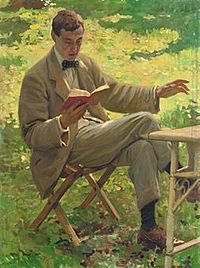
Alfred Munnings Reading Aloud Outside on the Grass, c. 1911, by Harold Knight
|
|
| Born |
Alfred James Munnings
8 October 1878 Mendham, Suffolk, England
|
| Died | 17 July 1959 (aged 80) Dedham, Essex, England
|
| Known for | Painting |
| Movement | Newlyn School |
Sir Alfred James Munnings (born October 8, 1878 – died July 17, 1959) was a famous English painter. He is best known for his amazing paintings of horses. He was also a strong critic of Modernism, which is a style of art that broke away from traditional ways.
After World War I, he received important jobs from Lord Beaverbrook's Canadian War Memorials Fund. These jobs helped him become very successful. From 1912 to 1914, he was part of the Newlyn School of artists. His artwork was even shown in the art competitions at the 1928 Summer Olympics, 1932 Summer Olympics, and 1948 Summer Olympics.
Munnings was the president of the Royal Academy of Arts from 1944 until 1949.
Contents
About Alfred Munnings
Alfred Munnings was born on October 8, 1878, in Mendham, Suffolk, England. His father was a miller, and Alfred grew up around a busy mill. This meant he saw many horses and horse-drawn carts every day.
When he was fourteen, he left Framlingham College. He then worked for a printer in Norwich for six years. During this time, he designed and drew advertising posters. He also studied art at the Norwich School of Art in his free time. After his training, he became a full-time painter.
In 1898, he had an accident and lost sight in his right eye. But this did not stop him from painting. In 1899, two of his paintings were shown at the important Royal Academy Summer Exhibition. He often painted scenes of country life, including Gypsies and horses.
He was connected with the Newlyn School of painters. In 1919, Munnings bought a house called Castle House in Dedham. He called it "the house of my dreams." He used this house and his studio there for the rest of his career. Today, it is the Munnings Art Museum.
In 1920, Munnings married again to Violet McBride, who also loved horses. They did not have any children. His second wife encouraged him to paint portraits for important people. But Munnings became most famous for his horse paintings. He often showed horses in hunting and racing scenes.
Munnings as a War Artist
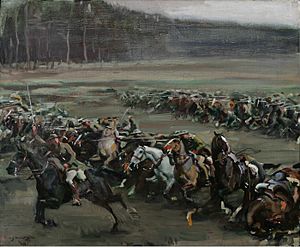
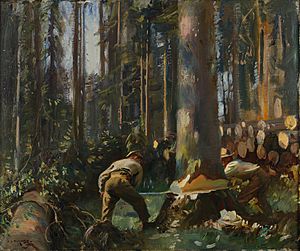
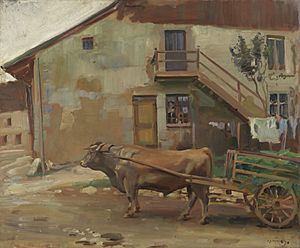
Even though Alfred Munnings wanted to join the army, he was not allowed to fight. In 1917, he worked a civilian job near Reading. His job was to help process thousands of Canadian horses that were being sent to France for the war. Later, he worked at a horse supply center on the Western Front.
Munnings's artistic talent was used as a war artist for the Canadian Cavalry Brigade. This was thanks to Max Aitken. During the war, he painted many scenes. In 1918, he painted a portrait of General Jack Seely riding his horse Warrior. Munnings painted this picture very close to the German front lines. When the general's unit had to quickly retreat, Munnings experienced what it was like to be under enemy fire.
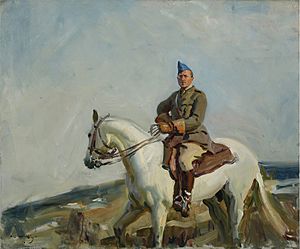
In 1918, Munnings also painted Charge of Flowerdew's Squadron. This painting shows a famous cavalry charge at the Battle of Moreuil Wood. Gordon Flowerdew was given a special medal, the Victoria Cross, for leading his soldiers in this brave attack.
The Canadian Forestry Corps also asked Munnings to visit their work camps in France. In 1918, he created drawings, watercolors, and oil paintings of their work. One painting was Draft Horses, Lumber Mill in the Forest of Dreux. Horses played a very important role in the war. They were used for transport and many other tasks. In fact, horse food was one of the biggest things sent to the front lines by some countries.
After the war ended in November 1918, forty-five of Munnings's paintings were shown at the Royal Academy.
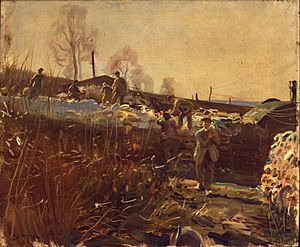
After the war, Munnings also started to create sculptures. Even though he didn't have formal training, he made an equestrian statue of Edward Horner. This was a team effort with his friend Sir Edwin Lutyens. This led to another job from the Jockey Club to sculpt the famous horse Brown Jack.
Later Career and Views on Art
Munnings became the president of the Royal Academy of Arts in 1944. He was also given the title of Knight Bachelor and later a Knight Commander of the Royal Victorian Order.
He is most remembered for a speech he gave in 1949. In this speech, he strongly criticized Modernism in art. His speech was broadcast on BBC radio and heard by millions. Munnings believed that the art of painters like Cézanne, Matisse, and Picasso was not good art. He even recalled a conversation with Winston Churchill about Picasso's art.
Munnings died at Castle House on July 17, 1959. His ashes were buried at St Paul's Cathedral. After he passed away, his wife turned their house in Dedham into a museum to show his artwork. A pub and a street in his hometown of Mendham are named after him.
Alfred Munnings was played by actor Dominic Cooper in the 2013 film Summer in February.
His Art at Auction
Munnings's paintings of sports and horses are very popular. They are well-loved in the United Kingdom, the United States, and other places. As of 2007, the highest price ever paid for one of his paintings was $7,848,000. This was for a painting called The Red Prince Mare. This painting was made in 1921 and is about 40 by 60 inches (100 by 150 cm).
His Books
Munnings wrote his life story in three books:
- An Artist's Life, London: Museum Press, 1950
- The Second Burst, London: Museum Press, 1951
- The Finish, London: Museum Press, 1952

